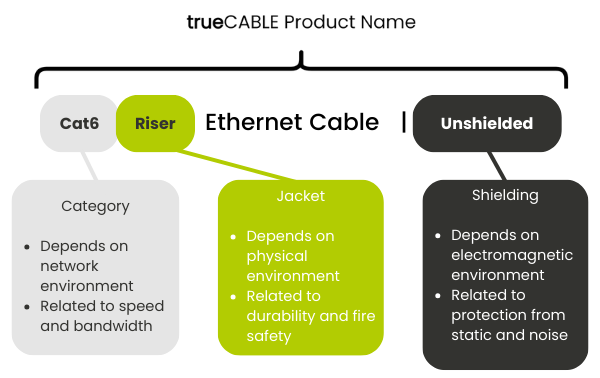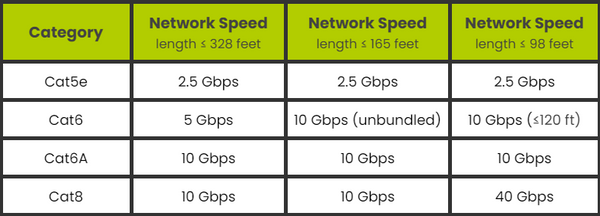How to Choose the Right Ethernet Cable
Written by Dave Harris, trueCABLE Technical Specialist, BICSI INST1, INSTC Certified
With so many different types of communications cable available to purchase, choosing the right Ethernet cable can be challenging. Terms like “plenum,” “riser,” and “shielded” aren’t in a regular person’s regular vocabulary, at least not as they pertain to structured cabling for an Ethernet network. This article is intended to demystify some of this terminology, and make it easier to understand the different environmental factors that should influence your choice of appropriate cable.
There are three basic criteria to consider when making your choice:
- Cable category
- Jacket composition
- Shielding
The cable category refers to the cable’s ability to perform at a certain speed and bandwidth, and is generally dictated by the capabilities of the devices making up the network. The category of the cable should be chosen according to the requirements of this network environment. The jacket composition refers to the chemical makeup of the cable jacket, conductor insulation, and other components that vary according to the physical environment where the cable will need to be installed. Shielding refers to the presence or absence of a metallic braided or foil layer that protects the Ethernet signal from electromagnetic interference. The electromagnetic environment is the presence or absence of electromagnetic interference or “noise.”
For any cable you choose, you will need to be familiar with the network environment so you can choose the appropriate category, the physical environment so you can optimize your jacket selection, and the electromagnetic environment to see if metallic shielding is required. Since these are the necessary criteria for choosing a cable for a particular purpose, they are also the criteria used for fully describing the cable. Therefore, these criteria are present in the product names for all of our Ethernet cable products. For example, our most popular Ethernet cable product is currently Cat6 Riser Ethernet Cable|Unshielded. The name includes the category (Cat6), the jacket composition (Riser), and whether it is shielded (Unshielded).

So, choosing the right Ethernet cable actually comes down to three basic decisions: category, jacket, and shielding.
Cable Category
The cable category should be chosen based on the speed at which the network is expected to operate and the bandwidth that is required. At this time, most home networks operate at 1 Gbps or less. Cat5e cable is more than adequate for those installations. In fact, Cat5e cable will handle data transmission speeds of up to 2.5 Gbps. It is also lighter, less expensive, and easier to work than the higher categories.
Network speeds are going up. Costs for high-speed hardware are coming down. Here in Kansas City, 5 Gbps Internet service is already publicly available, with even higher speeds on the way. For those speeds, Cat6 cable is necessary. Cat6 can handle up to 10 Gbps so long as your unbundled channels are shorter than 165 feet. For longer channels, Cat6A cable will be needed to transmit at 10 Gbps. Cat6A also offers higher bandwidth which is important as each channel must be able to connect more and more devices. Due to ever-increasing bandwidth requirements, we recommend Cat6A cable for all new construction. It is the best choice for future-proofing your network.
Category 7 cable is not a recognized standard in North America, and is rarely specified for installation here.
Category 8 cable can support speeds of up to 40 Gbps, but only for relatively short distances. It is heavily shielded at the jacket and conductors, and is very rigid. At this time, it is mostly useful in data centers.

Table 1. Ethernet cable categories and their maximum speeds with distance limitations.
Jacket Composition
It is important to select the right cable for the physical environment into which the cable will be installed. These decisions are made to maximize Ethernet cable reliability and durability. The most obvious place to start is to decide if the cable is to be installed indoors or outdoors. The materials used in indoor cable are different to the materials used in outdoor cable. Outdoor cable is not fire-rated and with few exceptions, may not be used indoors. The materials used in indoor cable to make it fire-resistant are not durable for outdoor use, and will quickly decompose when exposed to water and UV radiation (sunlight). Within the two broad classifications of “indoor” and “outdoor” there are more decisions to be made.
Indoor
For most indoor installations, both commercial and residential, riser cable is the best choice. It meets all of the standards and codes for fire safety, and is designed to be installed in walls, above ceilings, and in cable trays or j-hooks for commercial buildings.
Some commercial buildings require installation of cable into a plenum space, which is a space that is part of the HVAC system. The spaces under raised floors and above suspended ceilings are often used as plenum spaces in commercial buildings. In a large building, smoke from burning cable in one area can cause a hazard in a remote and otherwise unaffected area of the building. For installation inside plenum spaces, plenum cable is required. The materials used in plenum cable are more fire-resistant than riser cable, and the combustion products are less toxic. Plenum cable is almost never necessary in a single-family residence.
Outdoor
We make our outdoor cable jackets from linear low-density polyethylene (LLDPE). This is what makes the cable water-resistant and UV-resistant. If the cable is designed to be installed above ground, it is simply referred to as outdoor cable.
If the cable is to be installed underground, direct burial cable should be chosen. In addition to the LLDPE jacket, direct burial cable contains either a water-blocking layer or a gel filling to prevent encroachment by water. Direct burial cable should be chosen even if the underground cable will be in conduit, since underground conduit routinely fills with water. For that case, and any other case where the cable is likely to be submerged, we recommend gel-filled cable. Since our direct burial cable and our outdoor cable share the same jacket formulation, the direct burial cable can also be installed above ground, if necessary.
More information about outdoor cable choices can be found in our Cable Academy blog article, “Selecting the Correct Outdoor Ethernet Cable.”
And if you would like to take a deep dive into different Ethernet cable jackets, take a look at “Facts About Ethernet Cable Jacket Ratings.”
Shielding
There are only two choices available here, shielded or unshielded. Shielded Ethernet cable contains a metallic barrier beneath the cable jacket. There are different types and arrangements of cable shields, but they are all designed to offer extra protection from electromagnetic interference and buildup of static charge. Other things being equal, shielded cable is more expensive than unshielded cable, but that does not necessarily make it better. If shielding is not needed, you can avoid the extra expense and some additional work by using unshielded cable.
So when is shielded cable needed? If you are building an aerial installation where the cable will be suspended between poles or other structures, shielded cable is necessary to drain off static charges that build up due to air movement. Our Cat6 Outdoor Ethernet Cable W/Messenger|Shielded cable is designed specifically for aerial installations.
Shielded cable is also needed when the Ethernet signal can be exposed to nearby sources of electromagnetic interference. Common sources include motors, generators and transformers. AC power cables can also be a source of electromagnetic interference. In order to avoid using shielded cable, keep parallel runs of power cable and data cable separated by eight inches or more. You can find more information about the uses of shielded cable in our Cable Academy blog article, “Shielded vs. Unshielded Cable.”
Selecting the correct Ethernet cable for your installation can be intimidating, but this information should help get you started. This guide is not comprehensive. For example, there are shielding types and jacket compositions that are not discussed here. However, we hope that this provides a useful reference for readers trying to learn about our products. We also have a handy Ethernet Cable Finder on our website to walk you through the selection process. If you would like more information or have questions, our Customer Success Team and Technical Team are always standing by to help.
Happy Networking!
trueCABLE presents the information on our website, including the “Cable Academy” blog and live chat support, as a service to our customers and other visitors to our website subject to our website terms and conditions. While the information on this website is about data networking and electrical issues, it is not professional advice and any reliance on such material is at your own risk.






















































